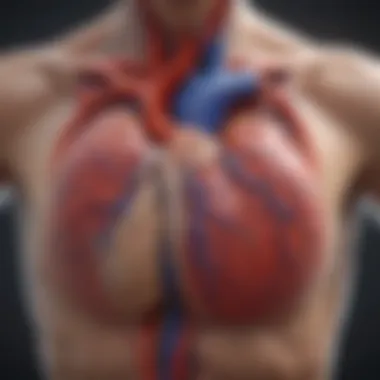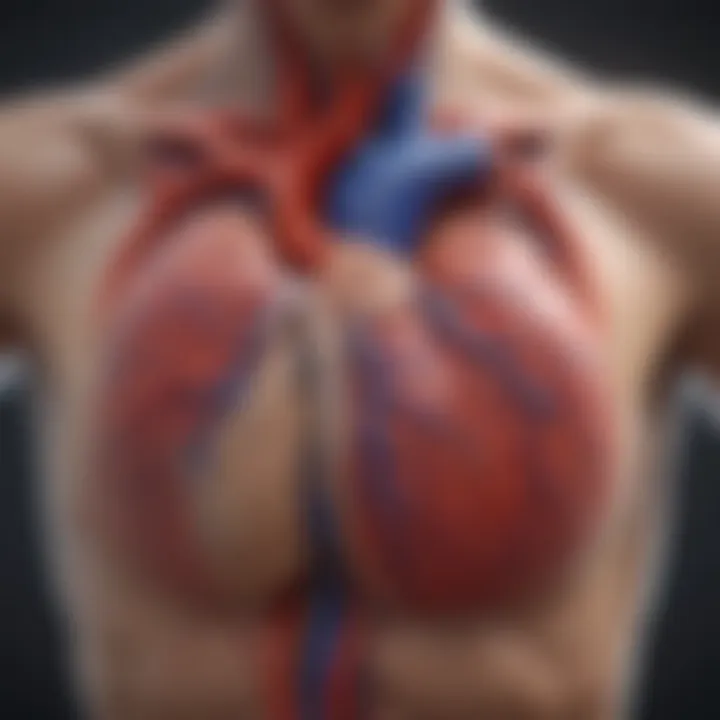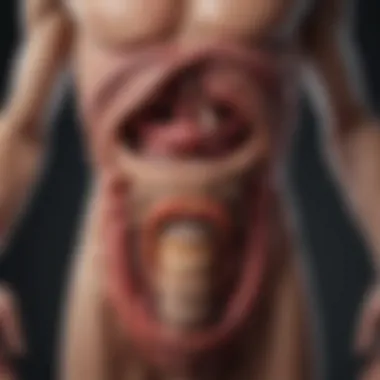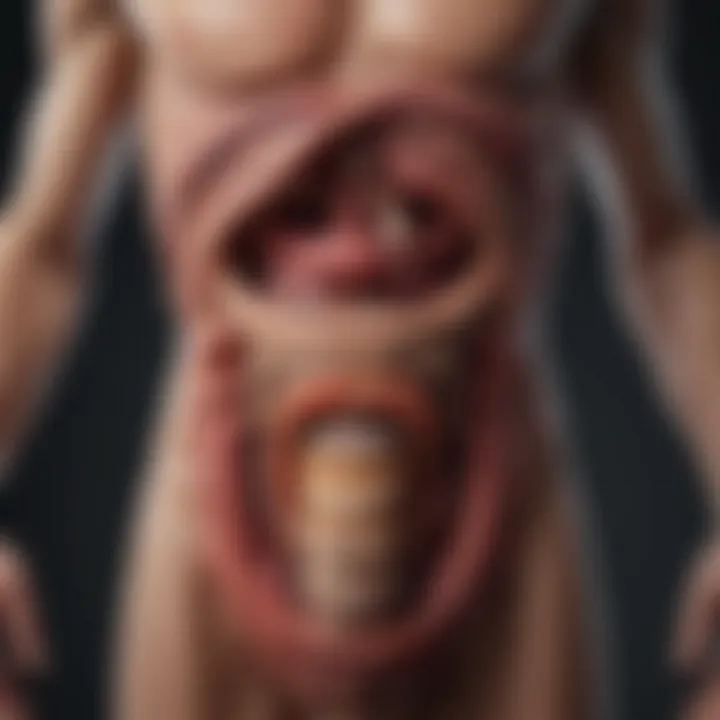Exploring the Human Body: An In-Depth Guide


Intro
The human body is a remarkable entity, an intricate tapestry woven with a multitude of systems that interconnect in fascinating ways. Each organ and system is like a piece of a puzzle, contributing to the greater picture of health and functionality. Understanding these components isn’t just an academic exercise; it’s the key to unlocking better health and deeper insights into our biology.
This examination of anatomy and physiology invites readers on a journey. With every vein, muscle, and organ, there lies a story of evolution, adaptation, and survival that spans centuries. We’ll explore how these systems work together to maintain homeostasis, ensure metabolism, and facilitate reproduction.
Moreover, appreciating the human body requires not only looking at its parts but also understanding the orchestration of these parts. From the simplest cell to the most complex interactions shared between systems, the body behaves almost like a symphony, where every section plays its role in harmony.
The goal of this atlas is to serve as a profound guide for students, educators, and professionals. By delving deeper into individual systems, we aim to illuminate connections and functionalities that may often be overlooked. Each section brings to light critical insights, making the complex world of human biology not just accessible, but engaging.
As we embark on this exploration together, be prepared to unlock the secrets of the human body, building a strong foundation of knowledge that can be applied in various fields ranging from medicine to personal health.
"The greatest wealth is health." - Virgil
With this foundation laid down, let’s navigate through the layers of our anatomical structures and appreciate the art of the human body.
Prelims to Human Anatomy
Understanding human anatomy is like peering under the hood of a finely tuned machine. The human body is a fascinating concoction of intricate systems working together harmoniously, each performing its specific role to maintain overall wellness. Grasping the fundamentals of these systems not only fascinates but also empowers individuals, whether they're budding medical professionals or simply curious about their own biology.
Defining Anatomy and Physiology
Anatomy and physiology are two sides of the same coin, yet they each hold their unique significance. Anatomy pertains to the structure of the body and its parts—taking a look at how things are built, while physiology delves into how these parts function collaboratively. Think of anatomy as the blueprint of the body, showcasing bones, muscles, organs, and tissues. Physiologically, it’s the dynamic processes behind how our heart pumps blood, how our lungs exchange gases, or how our stomach digests food. Together, they create a complete picture; without one, the other remains incomplete. The study of these subjects ignites curiosity about how the body operates at various levels, from cellular interactions to complex system functions.
Importance of Understanding the Human Body
When one takes the time to understand how their own body works, it leads to a plethora of benefits. Knowledge about human anatomy and physiology can lead to:
- Improved Health Awareness: Knowing how various systems operate helps individuals recognize signs of illness or imbalance. One learns to listen to their body, which is crucial for early detection and treatment for various health issues.
- Informed Lifestyle Choices: Understanding how nutrition fuels the body’s functions can lead to healthier eating habits. Likewise, awareness about the muscular system informs exercise routines.
- Empowerment and Self-care: A fortified understanding encourages proactive health behaviors. It enables people to engage effectively with healthcare providers about their health concerns.
In a nutshell, understanding human anatomy is not just for medical students; it’s a life skill that brings clarity and empowerment. As we delve deeper into each body system in this atlas, the aim will be to not only present data but to enhance that understanding even further, connecting theory with practical applications in daily life.
Skeletal System Overview
The skeletal system serves as the framework of the human body, an intricate construct made up of bones, cartilage, and joints that not only supports our structure but also plays a crucial role in movement and protection. Understanding this system is key for anyone eager to digest the complexities of human anatomy. From providing leverage for muscles to safeguarding vital organs, the skeletal system is fundamental in maintaining both posture and balance, reinforcing the idea that it’s more than just a series of bones.
This section dives into the mechanics of major bones and their functions, alongside the pivotal role of cartilage and joint structures. Insights into these components will allow for a thorough appreciation of how they contribute to our overall physiology. Moreover, recognizing the long-term impacts of injuries or diseases affecting the skeletal system can inform better health practices and treatment methods.
Major Bones and Their Functions
Bones are not merely rigid structures; they are dynamic tissues, constantly remodeled throughout life. Here, we will explore some of the most significant bones and their respective functions:
- Skull: Protects the brain while facilitating the sensory organs such as eyes and ears. It’s the cradle of our thoughts and identities.
- Vertebrae: These small, interlocking bones compose the spine, which not only protects the spinal cord but also allows for a wide range of motions.
- Ribs: Form the ribcage, safeguarding the heart and lungs while providing support for breathing.
- Femur: The longest bone in the body, crucial for supporting weight and enabling bipedal locomotion.
- Pelvis: Acts as a foundational structure for the lower body, connecting the spine to the legs and housing reproductive organs.
Each of these bones comes with distinct responsibilities, demonstrating how interconnected and dependent the functions of the skeletal system are.
Cartilage and Joint Mechanics
Cartilage is the unsung hero of the skeletal system. It’s this flexible and connective tissue that cushions the joints, ensuring smooth movements without friction. When discussing joint mechanics, it’s important to recognize a few key elements:
- Types of Cartilage:
- Joint Types:
- Hyaline Cartilage: Mostly found in growing bones and at joint surfaces, it’s the most common type.
- Elastic Cartilage: Found in structures like the ear, it provides both strength and flexibility.
- Fibrocartilage: Rigid and dense, it’s located in areas such as the spine, providing support and absorbing shock.
- Synovial Joints: Freely movable and encased in fluid, these joints allow for a breadth of motion and flexibility. Examples include the knees and elbows.
- Cartilaginous Joints: Here, the bones are connected by cartilage, allowing for limited movement, like in the spine.
- Fibrous Joints: These joints are tightly bound by connective tissue, resulting in no movement at all, as seen in the skull.
Understanding the roles of cartilage and the various joint types is vital, especially in the context of injuries or conditions such as arthritis, which can significantly impair mobility. Each element contributes to the symphony of movement that is human locomotion, highlighting the elegance of evolutionary design.
"The skeletal system is a masterpiece of engineering, intricately designed for resilience and flexibility."
In summary, the skeletal system is more than a passive assembly of bones. It’s a complex network of structural and functional components, each essential to our ability to move and live. By examining this system in depth, we gain valuable insights that can inform health practices and guide future research.
Muscular System Dynamics
The muscular system occupies a central role in the anatomy of the human body. Its dynamics are not merely about movement; it’s intricately tied to our overall health and functionality. Understanding this system allows us to appreciate how muscles work together to maintain posture, produce heat, and facilitate movement, effectively making the body a cohesive unit.
When one talks about muscular system dynamics, it’s not just about lifting weights or running. This discussion delves deeper into how various types of muscles interact, how they respond to different stimuli, and the implications for our health and wellness.
Types of Muscles: Skeletal, Cardiac, and Smooth
The human body houses three primary types of muscles, each with unique characteristics and functions:
- Skeletal Muscles: These are the muscles attached to bones, responsible for voluntary movements. They are striated in appearance and work in pairs to facilitate movement. For instance, when you flex your bicep, the skeletal muscle contracts, pulling the forearm upward.
- Cardiac Muscle: Limited to the heart, this muscle type works involuntarily and is crucial for pumping blood. Unlike skeletal muscles, cardiac muscle is both striated and branched, allowing for a coordinated contraction that is essential for effective blood circulation.
- Smooth Muscles: Found in the walls of hollow organs such as the intestines and blood vessels, these muscles operate involuntarily. They provide essential functions like constricting blood vessels or moving food through the digestive tract. Smooth muscles blend into our body's autonomous operations, often unnoticed yet vital.
Each muscle type serves distinct functions yet works interconnectedly, reflecting the body’s complex system.
Muscle Contraction and Movement
To grasp how the muscular system operates, it's vital to understand the mechanics behind muscle contraction and how this leads to movement. The process initiates with a signal from the nervous system, leading to a series of biochemical events within each muscle fiber.
"Muscle contraction is a finely tuned collaboration of different components adhering to precise sequences, transforming electrical signals into motion."
- Nerve Impulse: Once the brain sends a signal through the spinal cord, motor neurons release a neurotransmitter known as acetylcholine at the neuromuscular junction, triggering contraction.
- Calcium Release: This neurotransmitter causes calcium ions to flow into muscle cells, a crucial player in the contraction mechanism.
- Sliding Filament Theory: Proteins within the muscle fibers, known as actin and myosin, contract through a process known as the sliding filament theory, facilitating the muscle shortening and leading to movement.
- Energy Usage: Each contraction requires energy in the form of adenosine triphosphate (ATP). Without sufficient ATP, muscles fatigue, reducing performance.
Understanding this process offers insights into not only how we move but also how factors like exercise, nutrition, and even aging influence our muscular ability. This knowledge is indispensable for students, educators, and health professionals aiming to promote healthier lifestyles or understand rehabilitation in physical therapy contexts.
By cruising through these layers of muscular dynamics, one develops a sharper lens on how our physical functions are much more than mere actions—they are the heartbeat of life itself.
Circulatory System Functions
The circulatory system, sometimes referred to as the cardiovascular system, is pivotal in sustaining life through the effective transport of nutrients, gases, hormones, and wastes. Understanding this system is not merely a chapter in a biology book; it’s a key to unlocking the mysteries behind how our body maintains homeostasis and responds to various physical demands. In this section, we will unpack the nuances of how this system operates and its myriad functions.
The Heart as a Pump
At the center of the circulatory system is the heart, often celebrated as the core of human existence. This muscular organ works relentlessly, beating approximately 100,000 times a day without a single coffee break. The heart is divided into four chambers: the right atrium, right ventricle, left atrium, and left ventricle. Blood flows through these chambers in a specific sequence, allowing oxygen-poor blood to be pumped to the lungs for oxygenation before being sent to the rest of the body.
A classic analogy commonly used is that the heart functions like a high-powered pump, ensuring that blood circulates efficiently. The left ventricle, known for its robust walls, is especially significant as it pumps oxygen-rich blood to every part of the body, showcasing the heart’s role as a central hub in our circulatory narrative.


"The heart is a lonely hunter, but it manages to keep the rhythm of life steady."
In understanding the heart's mechanics, one must also consider its electrical conduction system, which coordinates heartbeats. Dysfunction in any part of this mechanism can lead to serious cardiovascular issues, highlighting the need for regular health checks to monitor heart performance.
Blood Vessels: Arteries, Veins, and Capillaries
Blood vessels form an expansive network throughout the body, akin to roads connecting various parts of a city. They are classified into three main types: arteries, veins, and capillaries. Each plays a distinct role, ensuring that blood reaches where it needs to go.
- Arteries: These vessels carry oxygen-rich blood away from the heart. Notable arteries include the aorta, which is the largest artery in the body, branching into smaller arteries that nourish the brain, limbs, and organs. The muscular walls of arteries help withstand and manage the high pressure of blood being pumped.
- Veins: In contrast, veins carry oxygen-depleted blood back to the heart. They have thinner walls than arteries and often have valves that prevent backflow, ensuring that blood progresses towards the heart with efficiency. The superior and inferior vena cavae are significant veins that drain blood from the upper and lower parts of the body, respectively.
- Capillaries: These tiny blood vessels form a crucial link between arteries and veins. Their walls are made from a single layer of cells, allowing for the exchange of gases, nutrients, and waste products between blood and surrounding tissues. The role of capillaries cannot be overstated as they serve as the site of gas exchange—a fundamental process in cellular respiration.
Understanding the interconnectedness of these blood vessels reveals a complex and efficient system that operates tirelessly to maintain life. Each component contributes to overall health, making it essential to take care of our circulatory system, primarily through maintaining a balanced lifestyle and regular check-ups.
Nervous System Architecture
The architecture of the nervous system is a cornerstone in our understanding of human biology. This complex and intricate network controls not only movements and reflexes but also the finer aspects of thoughts and emotions. By dissecting the nervous system's structure and functionality, we gain insights that extend into various fields of medicine, psychology, and even philosophy. The interplay between different components helps maintain homeostasis, allowing the body to function optimally.
Central vs Peripheral Nervous System
The nervous system can be broadly divided into two categories: the central nervous system (CNS) and the peripheral nervous system (PNS). Each part contributes uniquely to how we process information, react to stimuli, and connect with our environment.
The central nervous system consists of the brain and spinal cord. It acts like the head of a well-oiled machine, processing incoming signals and orchestrating responses. This is where higher-level functions, such as reasoning and memory, take place. The brain serves not only as a control center but also as a hub for emotions and communication.
On the other hand, the peripheral nervous system serves as a relay station between the CNS and the rest of the body. It comprises a network of nerves that branch out from the spinal cord and extend to every corner of the body. This includes both sensory nerves, which gather information from the external environment, and motor nerves, which send commands from the brain. Without this seamless communication, our actions could become clumsy or even chaotic.
"The nervous system is a vast, intricate web of communication lines, transmitting messages that regulate every aspect of our being."
Neurons and Neurotransmission
At the heart of the nervous system's architecture are neurons, often dubbed the building blocks of this complex system. These specialized cells are responsible for transmitting information throughout the body. Each neuron acts like a tiny messenger, relaying electrical signals that carry information from one part of the body to another. The structure of a neuron is designed for efficiency: dendrites receive signals, while the axon transmits them.
Neurotransmission refers to the process by which these signals are communicated from one neuron to another. It can be likened to handing off a baton in a relay race. When a signal reaches the end of an axon, neurotransmitters are released into the synaptic cleft—the tiny gap between neurons. Here, these chemicals bind to receptors on the receiving neuron, propagating the message onward.
The efficiency of this process is paramount. Any disruption in neurotransmission can lead to a host of issues, ranging from mood disorders to neurological diseases. This highlights the delicate balance maintained within the nervous system, and why understanding these functions is crucial for both health and wellness.
In summary, the architecture of the nervous system, through its central and peripheral components, and the intricate web of neuron signaling, plays a critical role in determining how we interact with the world around us. Understanding this architecture gives us key insights into biological processes, mental health, and even advancements in medical treatments.
Endocrine System Regulation
The endocrine system acts as a silent architect, shaping our body's functions through a complex interplay of hormones. While it may not get the same spotlight as the heart or brain, the significance of the endocrine system cannot be overstated. This system regulates metabolism, growth, and even mood by releasing hormones directly into the bloodstream, influencing various processes across multiple organ systems. In this section, we will explore the key glands and their hormonal duties, as well as the critical mechanisms that uphold homeostasis within the body.
Key Glands and Hormonal Functions
The human body is home to several glands that form the backbone of the endocrine system. Here’s a look at some of the most prominent ones:
- Pituitary Gland: Often referred to as the "master gland," this pea-sized organ controls other glands and regulates growth and water balance by secreting various hormones.
- Thyroid Gland: Located in the neck, the thyroid produces hormones that influence metabolism, energy generation, and overall growth. Thyroxine and triiodothyronine are two key hormones produced here.
- Adrenal Glands: Sitting atop each kidney, these glands are responsible for producing hormones related to stress response, such as cortisol and adrenaline. They play pivotal roles in metabolism and immune response.
- Pancreas: It serves dual functions in the body, both endo- and exocrine. Insulin, the most well-known hormone produced by the pancreas, is vital for regulating blood sugar levels.
- Gonads (Testes and Ovaries): These reproductive glands produce hormones like testosterone, estrogen, and progesterone, which are crucial for sexual development and reproductive functions.
The hormones released by these glands travel throughout the body, each targeting specific tissues and organs. This process ensures that every cell receives the instructions it needs to maintain normal function and respond appropriately to internal and external stimuli.
Homeostasis and Feedback Mechanisms
Homeostasis refers to the body's ability to maintain a stable internal environment, despite changes in external conditions. The endocrine system plays a crucial role in this balancing act through feedback mechanisms. Here’s how it works:
- Negative Feedback: The most common type of feedback loop. For example, when blood sugar levels rise, the pancreas releases insulin. This hormone helps cells absorb glucose, lowering blood sugar levels. Once levels normalize, insulin secretion decreases.
- Positive Feedback: Less common but equally important. During childbirth, the release of oxytocin stimulates contractions, which in turn prompts more oxytocin release, amplifying the process until delivery occurs.
Understanding these feedback mechanisms is essential since disruptions can lead to significant health issues. For instance, failures in insulin production can lead to diabetes, while thyroid dysfunction can result in metabolic disorders.
"The endocrine system's communication is a symphony, orchestrated by hormones that fine-tune bodily functions, ensuring that everything runs like a well-oiled machine."
Both the glands and their hormones intertwine with various body systems, creating a web of interactions that uphold health. Learning about this system not only enhances our comprehension of biology but also highlights the importance of maintaining a balanced lifestyle—one that nurtures all body systems, including the often-overlooked endocrine system.
Respiratory System Mechanics
The respiratory system plays a crucial role in maintaining the overall health of the human body. Its primary function is to facilitate gas exchange in order to supply oxygen to the blood while removing carbon dioxide, a waste product of metabolism. This section delves into the anatomy of the respiratory tract and the crucial process of gas exchange, establishing the importance of respiratory mechanics in daily bodily function and overall vitality.
Anatomy of the Respiratory Tract
The respiratory tract is a complex network of structures that work together to ensure efficient breathing and gas exchange. It begins with the nose or mouth, where air enters the body. The nasal cavity, lined with mucous membranes, warms, humidifies, and filters the incoming air.
Following this, air travels down the pharynx and through the larynx, where sound is produced. The trachea, also known as the windpipe, branches into two bronchi, each leading into a lung. Within the lungs, the bronchi further divide into smaller bronchioles, culminating in tiny air sacs known as alveoli.
"The alveoli are where the magic happens — a staggering 300 million of them in an adult lung ensures a large surface area for gas exchange."
Some key components of the respiratory tract include:
- Nasal cavity: Cleans and conditions inhaled air.
- Trachea: Provides a pathway for air to reach the lungs.
- Bronchi: Distribute air throughout the lungs.
- Alveoli: Sites of oxygen and carbon dioxide exchange.
Understanding the structural hierarchy of the respiratory tract provides insight into how efficiently oxygen can be delivered to the blood, impacting every cell in the body.
Gas Exchange and Its Importance
Gas exchange refers to the biological process where oxygen and carbon dioxide are exchanged across the alveolar membrane. It's vital for sustaining life; without this exchange, cellular respiration cannot occur, leading to cell death. When we inhale, oxygen fills the alveoli, where it diffuses into the capillary blood vessels that surround them. Simultaneously, carbon dioxide diffuses from the blood into the alveoli to be exhaled.
The mechanics of gas exchange involve several factors:
- Concentration gradients: The difference in concentration of gases drives the diffusion process. Oxygen is higher in the alveoli, while carbon dioxide is higher in the blood.
- Surface area: The extensive surface area of the alveoli maximizes gas diffusion capacity.
- Membrane thickness: A thinner alveolar-capillary membrane speeds up gas exchange.
A healthy respiratory system efficiently manages gas exchange under various physical conditions—whether at rest or during intense exercise. Moreover, disruptions in this process can lead to serious health issues, like respiratory illnesses, that compromise oxygen delivery and overall health.
In sum, the respiratory system is a beautifully intricate design, vital for sustaining life, while its mechanics influence countless other bodily functions. Understanding its role not only enriches our knowledge of human anatomy but underscores the importance of maintaining respiratory health.
Digestive System Pathway
The digestive system serves as the body’s fuel factory, transforming the food we eat into energy and nutrients essential for survival. Understanding the digestive pathway is vital as it showcases how our bodies break down complex substances into simpler, usable forms. The efficient functioning of this system not only supports individual health but also plays a pivotal role in maintaining overall bodily functions. If there’s a hitch in this process, it could lead to various health complications, making the understanding of this pathway worthwhile for students, researchers, and practitioners alike.
Key Organs and Their Functions
The digestive pathway comprises a series of organs that work in harmony to break down food. The mouth is where digestion begins; enzymes in saliva initiate the breakdown of carbohydrates. From there, the food travels down the esophagus into the stomach. Here, gastric acids and more enzymes continue the digestive process, turning food into a semi-liquid substance known as chyme.
Next, the chyme moves into the small intestine, which is a key player in nutrient absorption. It’s fascinating to note that the small intestine is divided into three parts: the duodenum, jejunum, and ileum, each with specialized functions:


- Duodenum: Receives chyme and mixes it with bile and pancreatic juices.
- Jejunum: Primary site for nutrient absorption.
- Ileum: Absorbs vitamin B12 and bile salts.
Once nutrients are absorbed, the remnants travel to the large intestine. Here, water is reabsorbed, and waste is formed. Finally, the rectum and anus are responsible for the expulsion of solid waste. Each organ plays an integral part in ensuring that nutrients from the food are effectively utilized, illustrating the intricate choreography of our digestive system.
Nutrient Absorption Processes
The process of nutrient absorption is remarkable, akin to a well-oiled machine working tirelessly. In the small intestine, the villi and microvilli, tiny finger-like projections, increase the surface area for absorption. This is where the magic happens—nutrients pass through the intestinal walls into the bloodstream.
The types of nutrients absorbed include:
- Carbohydrates: Broken down into simple sugars like glucose.
- Proteins: Split into amino acids.
- Fats: Emulsified by bile to form fatty acids and glycerol.
- Vitamins and minerals: Absorbed alongside other nutrients.
It’s interesting to consider how conditions like celiac disease can disrupt this delicate process. Those suffering from it may find their villi damaged, leading to poor nutrient absorption and various health issues. Maintaining a balanced diet and ensuring efficient digestion isn’t just a matter of comfort; it significantly impacts overall health. For anyone studying or working in health-related fields, comprehending these nuances is essential.
"The human body is a complex array of systems, and understanding the digestive pathway is crucial for maintaining health."
In summary, the digestive system’s pathway not only highlights the complexity and efficiency of our bodily functions but also emphasizes the importance of nutrition in our daily lives.
Urinary System Functions
The urinary system plays a vital role in maintaining homeostasis, which is crucial for overall health. Essentially, this system acts as the body's natural filtration system, responsible for removing waste products and regulating fluid balance. Understanding the urinary system is important as it affects various bodily functions, ranging from volume control to the elimination of toxins. It also influences blood pressure and electrolyte levels, linking it to numerous conditions, including hypertension and kidney disease.
By examining how this system operates, we can appreciate the intricate balance our body maintains to keep us in good health. The urinary system's functions not only highlight its necessity in waste excretion but also illustrate its involvement in broader physiological processes.
Kidney Structure and Functionality
The kidneys are the primary organs of the urinary system, looking somewhat like kidney beans. They're located on either side of the spine and play a pivotal role in filtering blood. Composed of millions of nephrons, the kidneys are where the magic happens; they filter waste from the blood and reabsorb what the body needs. Each nephron contains a glomerulus and a tubule, working together to purify the blood.
Another noteworthy feature is the renal cortex and medulla, areas that house the nephrons and aid in urine concentration. The former is the outer layer, while the latter is the inner part of the kidney. More than just waste removal, kidneys also regulate electrolytes and balance blood pH.
Important Fact: Each kidney contains about one million nephrons, emphasizing their efficiency and importance in bodily functions.
In short, understanding the structure is crucial to discerning their functionality.
Fluid and Electrolyte Balance
Fluid and electrolyte balance is essential for bodily functions, and the kidneys are at the forefront of this regulation. The kidneys manage the levels of sodium, potassium, and other electrolytes, ensuring they remain within a narrow range. This balance is vital for nerve function, muscle contractions, and overall cellular processes.
Here are a few key points regarding fluid and electrolyte balance:
- Sodium Regulation: Sodium is crucial for maintaining blood volume and pressure. The kidneys adjust sodium reabsorption based on the body's needs.
- Potassium Balance: Potassium is essential for heart function. Too much or too little can lead to severe health issues; thus, the kidneys are constantly working to regulate this electrolyte.
- Acid-Base Balance: The kidneys also play a critical role in maintaining pH balance by excreting hydrogen ions and reabsorbing bicarbonate from urine.
- Hydration: The balance of fluids in the body affects hydration levels, which is essential for all bodily systems to function.
In summary, the urinary system, particularly through the kidneys, is vital for regulating fluid and electrolyte balance, ultimately keeping the body's environment stable and functional.
Reproductive System Overview
The reproductive system might not get as much attention as other body systems, but it plays a pivotal role in human existence. Without it, none of us would be here, which speaks volumes about its significance. This system is not merely about reproduction; it's about creating life and ensuring the continuity of our species. Understanding its intricacies helps appreciate the complexity and beauty of human biology.
Furthermore, a solid grasp of the reproductive system informs us about various health issues, from menstrual cycles to prostate health. This knowledge isn’t just for academics or healthcare professionals; it’s beneficial for everyone. Knowing how the reproductive system functions can lead to better health decisions and an understanding of personal well-being.
Male and Female Anatomical Structures
The reproductive system consists of unique anatomical structures for both males and females. Each part has a distinct function, ensuring the reproductive process runs smoothly.
- Male Reproductive Organs:
- Female Reproductive Organs:
- Testes: These are responsible for sperm production and testosterone secretion. They play a critical role in male fertility.
- Penis: Not only serves as the copulatory organ, but it also facilitates the expulsion of urine.
- Seminal Vesicles & Prostate Gland: These contribute fluids that nourish sperm and create the ejaculate, vital for reproduction.
- Ovaries: They produce eggs and hormones like estrogen and progesterone. The management of the menstrual cycle hinges on these glands.
- Fallopian Tubes: Essential for transporting the egg from the ovaries to the uterus, where fertilization typically occurs.
- Uterus: Often referred to as the womb, it provides a nurturing environment for a developing fetus.
This division of structures clearly reveals that while the functioning styles may differ, the aim of both male and female reproductive systems remains the same: the propagation of the species.
Role of Hormones in Reproduction
Hormones guide and orchestrate the myriad processes within the reproductive system. They are the unseen conductors of this biological symphony, determining everything from sexual development to reproductive cycles.
- Testosterone in Males: Testosterone is crucial in the development of male genitalia and secondary sexual characteristics, such as muscle mass and hair growth. Its role extends far beyond the physical; it influences libido and contributes to behaviors often associated with masculinity.
- Estrogen and Progesterone in Females: These hormones govern the menstrual cycle and are integral to preparing the body for potential pregnancy. Understanding their fluctuations can help in recognizing fertility patterns and managing health during different life stages, such as puberty and menopause.
"Hormones don’t just regulate the reproductive system; they are also influential in emotional and physical changes throughout life."
Grasping how these hormones interact provides clarity on broader health issues. For instance, hormonal imbalances can lead to a variety of challenges, from infertility to mood disorders, making this knowledge essential for health literacy.
By exploring the reproductive system's structures and the hormonal intricacies, we unveil a critical part of the human experience. This section serves as an introduction to a complex and multifaceted domain, encouraging further exploration into the wonders of human anatomy.
For further resources on human anatomy, check out the detailed guides at Britannica or explore discussions on anatomical topics at Reddit.
Integumentary System Insights
The integumentary system serves as a vital boundary between the human body and the external environment. Its primary components—skin, hair, and nails—play critical roles in protecting internal organs, regulating temperature, and sensing external stimuli. Beyond the basic functions, this system offers unique insights into health, as it reflects one's physiological state. Understanding the integumentary system is crucial for students and professionals across various disciplines, including medicine, biology, and dermatology.
Skin: Structure and Function
At first glance, the skin may appear as a simple outer layer, yet it's an intricate structure composed of multiple layers, each with distinct roles. The epidermis, the outermost part, acts as a protective shield against pathogens and harmful substances. Beneath it lies the dermis, which contains connective tissue, blood vessels, and nerve endings. This layer is where a variety of complex processes occur.
Key functions of the skin include:
- Protection: The skin guards against physical, chemical, and microbial hazards.
- Temperature Regulation: Through sweat glands and blood vessel constriction or dilation, the skin plays a fundamental role in maintaining body temperature.
- Sensation: Numerous nerves within the skin transmit sensations such as touch, pain, and temperature, which are critical for interactions with the environment.
- Vitamin D Synthesis: Upon exposure to sunlight, the skin synthesizes Vitamin D, an essential compound for bone health.
Understanding these elements not only highlights the importance of skin care but also sheds light on how various conditions can affect skin health. As the saying goes, "you can't judge a book by its cover," but in the case of health, a lot can be gleaned from the skin's appearance.
Hair and Nails: Their Role
Hair and nails may seem ancillary to the primary functions of the integumentary system; however, both serve essential purposes that contribute to overall health and functionality. Hair protects delicate areas, facilitates thermoregulation, and is involved in sensory functions. For example, the fine hairs on our arms can detect slight changes in the environment, such as the presence of insects.
On the other hand, nails provide support and protection for the tips of fingers and toes, enhancing dexterity and fine motor skills. The structure of nails is quite fascinating; they are made primarily of a protein called keratin, similar to that found in hair.
The health of hair and nails can indicate underlying health issues, such as nutritional deficiencies or hormonal imbalances. Here are some insights about their significance:
- Hair: Abnormal hair loss or changes in texture can hint at systemic conditions or emotional stress.
- Nails: Discoloration, brittleness, or changes in shape can signify insufficiencies or even chronic illness.


In summary, caring for the integumentary system is not just about aesthetics; it also plays a profound role in overall wellness. As the protector and indicator of our internal health, the integumentary system deserves focused attention in both academic exploration and clinical practices.
"The skin is a reflection of your health; nurture it well, and it will serve you faithfully."
Lymphatic and Immune Systems
Understanding the lymphatic and immune systems is fundamental to grasping how our body maintains health and fights diseases. These two systems work hand in hand, orchestrating a symphony of responses that protect us against infections and maintain fluid balance. By exploring the components of the lymphatic system and the mechanisms of immune responses, readers can appreciate the intricacies involved in sustaining life.
Components of the Lymphatic System
The lymphatic system is composed of several key components that play vital roles in bodily functions:
- Lymphatic Vessels: These vessels transport lymph, a clear fluid that contains white blood cells, throughout the body. They are like highways for immune cells.
- Lymph Nodes: Scattered throughout the lymphatic vessels, lymph nodes act as filters. They trap pathogens and foreign particles, allowing the body to mount an immune response.
- Spleen: Considered the body's largest lymphatic organ, the spleen processes blood and produces lymphocytes, essential for fighting infection.
- Thymus: Located behind the sternum, the thymus is crucial for T-cell maturation, helping to develop the body’s frontline defense against pathogens.
The lymphatic system also includes other tissues like tonsils and Peyer’s patches, each contributing to our immune defenses. This interconnected network not only aids in immune responses but also assists in maintaining proper fluid balance, preventing swelling and tissue damage.
Immune Responses and Mechanisms
Now, how does the immune system actually work? It can be broken down into several categories:
- Innate Immunity: This is the body’s first line of defense. It includes physical barriers like skin, cellular components like macrophages, and biochemical substances like enzymes. Quick and non-specific, innate immunity responds immediately to pathogen invasion.
- Adaptive Immunity: This system kicks in when innate immunity is insufficient. It involves lymphocytes such as B-cells and T-cells that recognize specific pathogens. Adaptive immunity is slower to activate but provides a more targeted approach.
- Humoral Response: B-cells produce antibodies, which bind to pathogens, neutralizing them or marking them for destruction by other immune cells.
- Cell-Mediated Response: T-cells regulate immune responses and directly kill infected cells, thus controlling microbial infections.
These immune mechanisms highlight the remarkable adaptability of the human body. The synergy between innate and adaptive systems allows for a refined response to diverse threats, ensuring our survival in a world teeming with pathogens.
"The immune system is like a complex orchestra, where each section, though unique, plays in harmony to protect the body from invaders."
In the grand scheme, the lymphatic and immune systems underscore the importance of maintaining health. They remind us that every part of our body has a role to play, and their efficiency can determine our overall wellness.
Interconnections Among Body Systems
Understanding the interconnections among the body systems is essential for comprehending how the human body operates as a cohesive unit. Each system—be it skeletal, muscular, circulatory, or any of the others—does not function in isolation; they are all interlinked in a highly complex web of interactions. This interconnectedness is crucial, as it influences health, function, and adaptability to various life conditions.
In tall trees of the forest, the roots dig deep into the earth, intertwining with those of other trees. Similarly, in our bodies, systems support and rely on each other, ensuring that we thrive. For example, think about how the circulatory system delivers oxygen from the lungs throughout the body; without the respiratory system, this couldn't happen effectively. Likewise, the endocrine system regulates metabolism and influences not just one system but several at once, impacting everything from growth to mood.
It’s not just about bones and muscles working together; it’s also how lifestyle choices impact these connections. Every morsel of food eaten isn’t just an isolated choice but weaves into the intricate web of physiological needs and processes, ushering nutrients through a variety of pathways, affecting blood sugar levels, hormonal balance, and overall metabolic rates.
"The beauty of the human body lies in its complexity and ability to adapt through its interconnected systems."
These interactions provide several benefits, notably when it comes to recovery from injury or illness. When one system falters, others often compensate to maintain overall function—a testament to the body’s remarkable resilience. Recognizing these interconnections can lead to better diagnostic and treatment strategies.
System Interactions and Health
The health of an individual reflects the state of their interconnected systems. If one system is compromised, it can lead to a domino effect, affecting others. For instance, chronic stress impacts the nervous system, which then influences the endocrine system, leading to various health issues like hypertension or diabetes.
- Holistic Approach: To grasp health fully, a holistic approach is necessary. This means looking at the body as an integrated whole rather than isolated parts. For instance, when treating a heart condition, it is also important to consider respiratory efficiency and metabolic health.
- Preventative Measures: Understanding these interdependencies allows for innovative preventative measures. Lifestyle changes addressing multiple systems—such as diet, exercise, and stress management—can enhance overall well-being.
Impact of Lifestyle on Body Systems
Lifestyle plays a pivotal role in the functionality of body systems. The choices one makes daily can either bolster these systems or undermine them, impacting overall health.
Take the example of physical activity: regular exercise strengthens the muscular and skeletal system, enhancing not just muscle condition but also bone density, a key factor in long-term health. Conversely, a sedentary lifestyle can result in a plethora of health issues that ripple through the interconnected systems.
- Nutrition: A balanced diet supports not only the digestive system but also affects hormonal balance (thanks to the endocrine system) and influences mental health through neurotransmitter production in the nervous system.
- Stress and Sleep: Chronic stress can elevate cortisol levels, leading to various downstream effects: it can increase blood pressure, disturb sleep cycles, and influence insulin sensitivity, impacting both the circulatory and metabolic systems.
By choosing a healthy lifestyle that emphasizes balance, individuals can maintain the intricate dance of body systems, ensuring their longevity and quality of life.
The relationship between our bodies and the external environment is symbiotic; by nurturing one, we bolster the other. In essence, our bodies reflect the choices we make, and understanding this complex relationship can empower individuals to take charge of their health.
Modern Techniques in Anatomy
As we dive into the intricate world of human anatomy, we find ourselves at the forefront of technological advancements that have revolutionized our understanding. Modern techniques in anatomy are not just enhancing traditional knowledge but are also pushing the boundaries of what's possible in medical science. By employing state-of-the-art imaging technologies and innovative learning tools, we can visualize and dissect human anatomy in ways previously thought impossible. This section will discuss the critical elements of these techniques, their benefits, and considerations that come with embracing these methods.
Imaging Technologies in Medical Sciences
Imaging technologies are among the most impactful advancements in the realm of anatomy, serving as essential tools for both diagnosis and education. Techniques such as MRI (Magnetic Resonance Imaging), CT (Computed Tomography) scans, and ultrasound have become staples in both clinical and educational settings.
- MRI provides high-resolution images of soft tissues, which is incredibly useful for visualizing structures like the brain or muscles. Thanks to its non-invasive nature, it has changed how we approach understanding various pathologies.
- CT scans deliver detailed cross-sectional images of the body, making it easier to identify and analyze complex anatomical structures. They offer speed and accuracy that radiologists and surgeons rely on during critical procedures.
- Ultrasound is perhaps the most accessible imaging technique, often used in prenatal care and routine diagnostics. It's an invaluable tool that uses sound waves to produce images without the use of radiation.
The importance of these technologies cannot be overstated. They not only facilitate accurate diagnosis but also empower educators to teach anatomy in more interactive and engaging ways. ~For instance, students can observe how a disease progresses within a live body, viewing not just the static images but also dynamic functions in real-time.
Virtual Dissection and Learning Tools
Virtual dissection tools are an exciting development in the field of anatomical education. Gone are the days when students had to rely solely on textbooks and physical models. These new technologies have made the learning process more interactive.
Platforms like Visible Body allow students to explore 3D models of human anatomy, zooming in on specific organs or systems to gain a clearer understanding. This can lead to a deeper grasp of complex structures that may be difficult to understand through traditional methods.
Additionally, virtual tools can help students:
- Learn in a customized manner, moving at their own pace.
- Engage with interactive quizzes and simulations that test their knowledge.
- Gain exposure to a wider array of conditions without the ethical concerns of real animal or human dissection.
One major benefit is that these tools cater to various learning styles, whether visual, auditory, or kinesthetic. Yet, it’s essential to recognize that while virtual dissections offer numerous advantages, they cannot substitute entirely for hands-on experience in understanding anatomy’s tactile elements.
The End and Future Directions
Reflecting upon the intricate web of human anatomy and physiology, the conclusion serves not just as a wrap-up but as a launching pad into broader horizons. Understanding the body's systems is more than a scientific endeavor; it’s a gateway to enhancing human welfare. Each segment of this atlas has illuminated the complexities of our bodies, showcasing features that are both astounding and foundational to life itself.
Summation of Key Components
The exploration throughout this article has stitched together the various halves of what makes up human anatomy. The skeletal system's support structures, the muscular system's movements, and even the intricate workings of the brain and nerves—each contributes to a magnificent whole. Here are some pivotal aspects discussed:
- Skeletal System: Forms the scaffold, protecting organs and facilitating motion.
- Muscular System: The powerhouse enabling movement and maintaining posture.
- Circulatory System: Ensures that nutrients and oxygen flow effectively through the body.
- Nervous System: Acts as the body's command center, processing signals and coordinating actions.
- Endocrine System: Regulates various functions through hormones, contributing to homeostasis.
The interconnectedness of these systems illustrates a broader truth: biology is not a collection of isolated parts but a cohesive mechanism where the failure of one can impact the entire organism. The insights gained here provide a foundational grasp that will be pivotal for future studies and applications, whether in academic, medical, or biotechnological fields.
Outlook on Future Research and Discoveries
The ever-evolving nature of human biology promises intriguing avenues for future discoveries. The accelerated pace of technological advancements means that new dimensions of research will continue to emerge, addressing unanswered questions about human health and anatomy. Some areas that demand attention include:
- Regenerative Medicine: Exploring the potential of stem cells in repairing tissues.
- Personalized Medicine: Understanding genetic variations for tailored therapies.
- Neurobiological Advances: Investigating the brain's complexities regarding consciousness and cognition.
- Integration of AI in Health Diagnostics: Utilizing artificial intelligence to revolutionize the interpretation of anatomical data.
"The only limit to our realization of tomorrow will be our doubts of today." - Franklin D. Roosevelt
As the landscape of medical science broadens, integrating cross-disciplinary approaches will be essential. Collaborating fields such as bioengineering, computer science, and molecular biology will equip researchers and medical professionals with tools to push the envelope of human understanding further.
In summary, the journey through this atlas has unveiled layers of depth within the human body. The pathway ahead is bright, full of promise for breakthroughs that can enhance quality of life and expand our grasp of what it means to be human.















